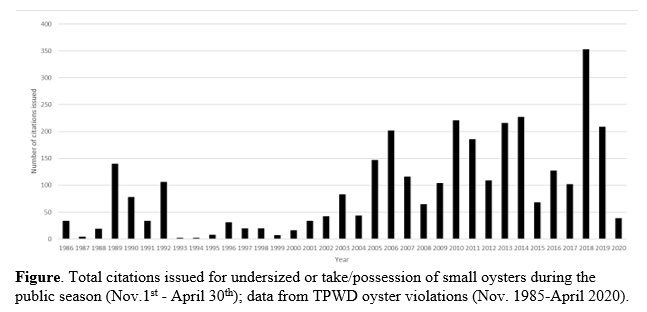ANALYSIS OF WILD UNDERSIZED OYSTER HARVEST IN TEXAS FOR DETERMINING FARM SIZE REGULATIONS
For many years, Texas has relied on the harvest of oysters in natural habitats approved by the Texas Department of Health Services. Due to increasing value of oysters, The Texas Parks and Wildlife Department (TPWD) was directed in 2019 to develop appropriate regulations for an off-bottom oyster mariculture program to become effective in September 2020. Regulatory issues of concern include size-based harvest, where the legal market-size cultivated oyster is 2.5 inches and legal market-size harvested (i.e., wild) oyster is 3.0 inches. TPWD considers this size difference as a critical challenge because there is a potential that undersized oysters acquired from public reefs could be sold through mariculture operations. An analysis of oyster violations was conducted to determine if undersize oyster harvesting is problematic in Texas and if this information could be used to deter undersized oysters from the wild harvest being illegally mixed into cultivated oyster production. An open-record request was made to TPWD for oyster violations data. The oyster violations data set had 6,483 recorded citations issued between November 1, 1985 and April 15, 2020. Of these citations, 4,029 (i.e., 62%, Figure) were for undersized or take/possession violations. The difference in harvest size (wild vs cultivated) may lead to a further increase in the undersized harvest, which is the number one category for violations. The use of current harvest documentation paired with enforcement should minimize chances of mixing wild with cultivated oysters, thus protecting the species and the natural resource.
